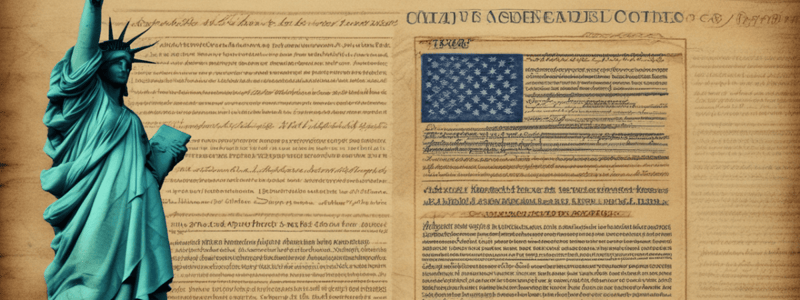Podcast
Questions and Answers
What Amendment extended the application of the Bill of Rights to state governments?
What Amendment extended the application of the Bill of Rights to state governments?
- 13th Amendment
- 9th Amendment
- 10th Amendment
- 14th Amendment (correct)
Which of the following rights is NOT protected by the Bill of Rights?
Which of the following rights is NOT protected by the Bill of Rights?
- Right to bear arms
- Freedom of religion
- Freedom of speech
- Right to privacy (correct)
What is one of the fundamental American documents along with the Declaration of Independence and the Constitution?
What is one of the fundamental American documents along with the Declaration of Independence and the Constitution?
- Emancipation Proclamation
- Gettysburg Address
- Civil Rights Act of 1964
- Bill of Rights (correct)
In what context has the Bill of Rights been increasingly used in debates over the past century?
In what context has the Bill of Rights been increasingly used in debates over the past century?
How does the interpretation and application of the Bill of Rights evolve over time?
How does the interpretation and application of the Bill of Rights evolve over time?
Study Notes
- The Bill of Rights is the collective name for the first 10 Amendments to the United States Constitution.
- The purpose of the Bill of Rights was twofold: to protect individual rights and to limit government power.
- The Bill of Rights was influenced by several declarations of rights throughout English history, such as the Magna Carta, the English Petition of Right, and the English Bill of Rights.
- The American colonists followed this model and created their own declarations asserting their rights as Englishmen and holding the British government accountable.
- After independence, most states created their own bills of rights, but the national government under the Articles of Confederation did not have a formal bill of rights.
- The idea of a federal Bill of Rights was raised during the Constitutional Convention, but it was unanimously rejected at that time.
- The debate over a bill of rights became central during the ratification process of the Constitution, with Anti-Federalists arguing for its necessity and Federalists arguing that the Constitution already protected individual liberties.
- Eventually, a compromise was reached, and the Federalists pledged to add a Bill of Rights during the First Congress.
- James Madison led the fight for the creation of the Bill of Rights and proposed integrating it into the text of the Constitution, although this proposal was not accepted.
- Congress agreed to 12 amendments, and ten of them, known as the Bill of Rights, were ratified in 1791.
- Initially, the Bill of Rights only applied to the federal government, but over time, through the 14th Amendment, it became applicable to state governments as well, limiting their ability to infringe on individual rights.
- The Bill of Rights protects essential rights such as freedom of religion, speech, press, assembly, and the right to bear arms, as well as due process of law.
- The Bill of Rights is considered one of the foundational American documents, along with the Declaration of Independence and the Constitution.
- Throughout the 20th and 21st centuries, the American people and the Supreme Court have increasingly relied on the Bill of Rights in debates concerning individual liberties.
- The Bill of Rights continues to protect individual liberties and limit government power, and its interpretation and application evolve over time.
Studying That Suits You
Use AI to generate personalized quizzes and flashcards to suit your learning preferences.
Description
Test your knowledge about the background, creation, and significance of the Bill of Rights in the United States, which protects essential individual liberties and limits government power. Learn about its historical context, debates during ratification, and ongoing impact on American society.




